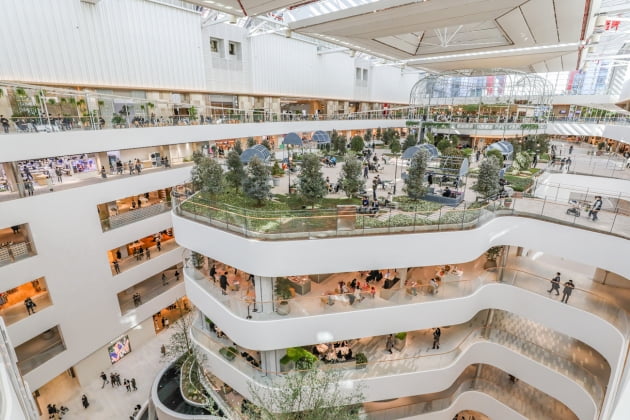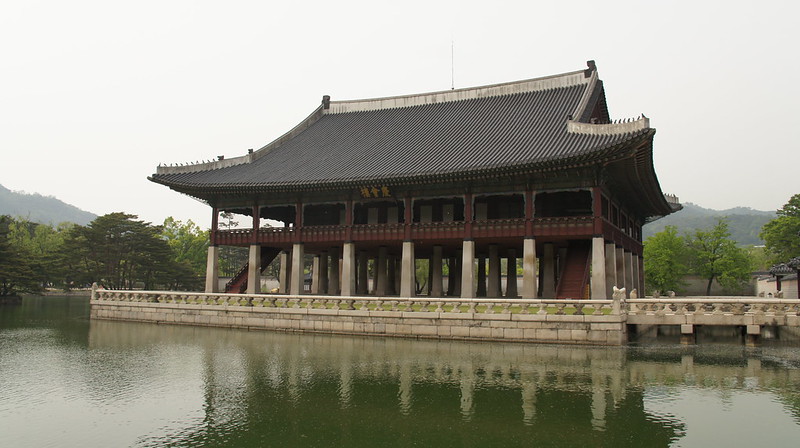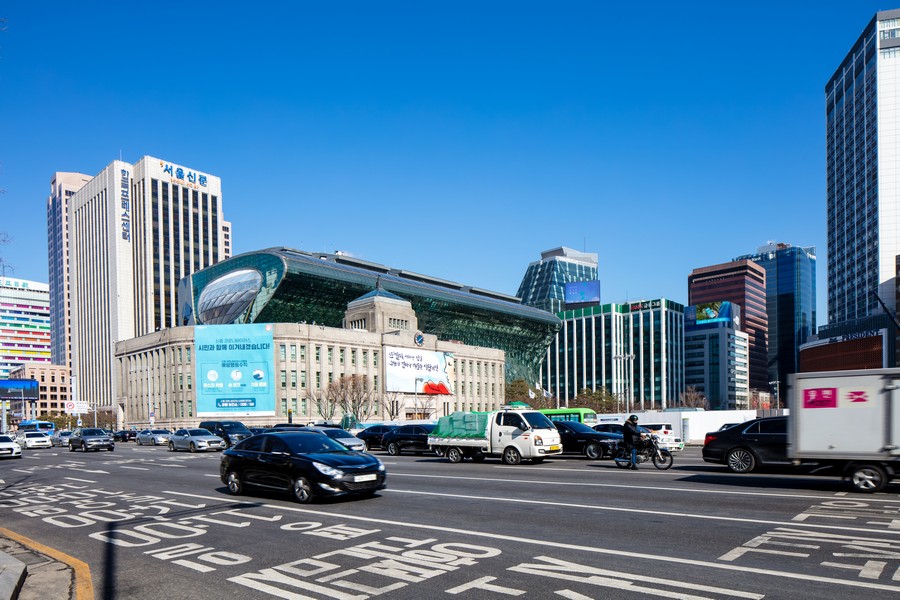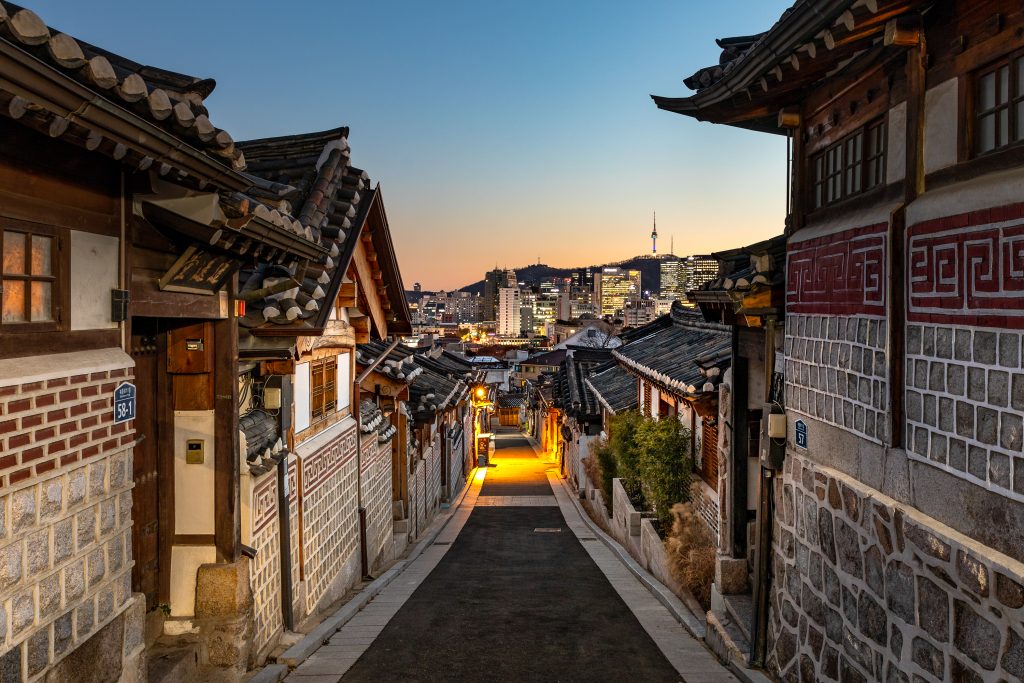Seoul’s largest department store, The Hyundai Seoul (더현대서울)’s website makes a bold claim: “Sound of the Future.” Visiting the building, one would find it difficult to challenge this statement. The shopping center, having only opened this past February, is a vision of futurism, with glacier white interiors, smooth curves that call back to designs from science fiction, and islands of foliage and waterfalls decorating both the floors and skies. The exterior pierces the sky, with bright red beams flowing down the sides. With such a striking design, it has immediately claimed a place in the legacy of Seoul architecture—a legacy with a long and complicated history. Throughout the Republic of Korea’s capital city, there are buildings like The Hyundai Seoul that provide us insight on not only the architectural influences imported into the country but also the history of the land and city itself.

a view of The Hyundai Seoul
Gyeongbokgung
Gyeongbokgung, in many ways, lies at the center of Korean history. Physically, it is in the geographic center of Seoul, its position being highly favored according to the Korean philosophy of pungsu (풍수), a form of geomancy. Historically, it acts as a representative of the Joseon Dynasty (조선), arguably the most important dynasty to the Korean peninsula. Built by the first king of Joseon, Yi Seong-gye (이성계), it is the centerpiece to a set of palaces built around Seoul. Gyeongbokgung is itself an organism, spanning almost half a square kilometer with pavilions and halls framed by foliage and ponds decorating the area. The space we see today has a history as complex as Seoul itself. While the palace was originally composed of around 500 buildings, due to fires in the late 1500s and demolition by the Japanese during the colonial period, much of the site was destroyed. The government has spent the last couple decades rebuilding, reconstructing, and conserving the palace, and the 100 buildings we see today are a result of those efforts. While aspects of Chinese design were incorporated into the architecture, the end result is undeniably Korean, and each compound and building inside is laced with detail, not only providing stunning visuals but information on the historical use and importance of each location.

Gyeonghoeru Pavilion
Seoul City Hall
At the end of Cheonggyecheon (청계천), one is met with a structure that noticeably stands out against the skyscrapers of Jung-gu (중구), the center of Seoul and a major financial and governmental district. A wide green surrounds the entrance to a building that would fit in the streets of London or New York City in the early 20th Century. Behind it, a tall glass building rises up, resembling a wave, curling and cresting. These two buildings together make up Seoul Metropolitan Library and Seoul City Hall. Seoul Metropolitan Library, the smaller of the two, is a remnant of the Japanese imperial era. Following its invasion and takeover of Joseon, Japan pursued major infrastructure projects in Seoul, often at the expense of previously existing cultural landmarks and buildings. The library’s aesthetic is a part of Imperial Crown Style, an architectural movement from Meiji-Era Japan that combined Western Neoclassical architecture with elements of traditional Japanese construction. It was the head of government for Japan’s imperial government in Korea and was later converted into City Hall following liberation. It was then reassigned as Seoul Metropolitan Library when the new City Hall, the glass building that sits behind it, took over its role in 2012. The new City Hall is the epitome of Korea’s present image: sleek, futuristic, and sustainable. The two buildings enter a dialogue on the entirety of modern Korean history. While the beginnings of its modernization are marked with Japanese imperial influence, the Republic of Korea has grown into its own, asserting its own technological dominance and becoming a major actor in shaping the trajectory of a globalized future.

Seoul City Hall and the Old Seoul City Hall
Bukchon Hanok Village
Seoul is a city where the past meets the future. Seoul and the surrounding area comprise one of the largest and most developed metropolitan areas in the world, yet even so sprinkled throughout the scenery of skyscrapers, LED, and highways are groves of rich history and culture. One such area is Bukchon Hanok Village, a small neighborhood nestled near Gyeongbokgung. What was historically a small community of nobility and the elite has become a national cultural landmark, as the traditional Korean houses located there function as a gateway to the past and an introduction to one of the oldest and most culturally significant forms of Korean architecture, called hanok (한옥). The houses, once a standard form of architecture in the country, have now become an icon of Korean cultural heritage due to their unique and environmentally sustainable design. Elements in the modern image of hanok, such as the natural building materials, ondol (온돌) heating systems, and exterior pillars, are present in houses dating back to the Iron Age, making hanok an example of pure Korean architecture and the hanok village a portal to the past. While Bukchon is labeled as a tourist site, residents still live in the hanok, proving the continued relevance hanok has in Korean society.

Bukchon Hanok Village
Written by: Curtis Feldner
Originally from Atlanta, Georgia, USA. Currently a 4th Year undergraduate pursuing a BS in Educational Studies at University of Wisconsin-Madison. Exchange student at Korea University and intern at VANK (Voluntary Agency Network of Korea)